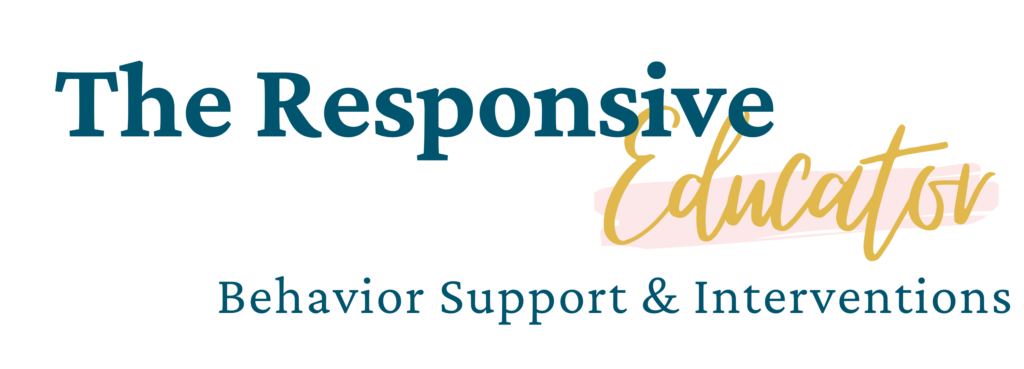
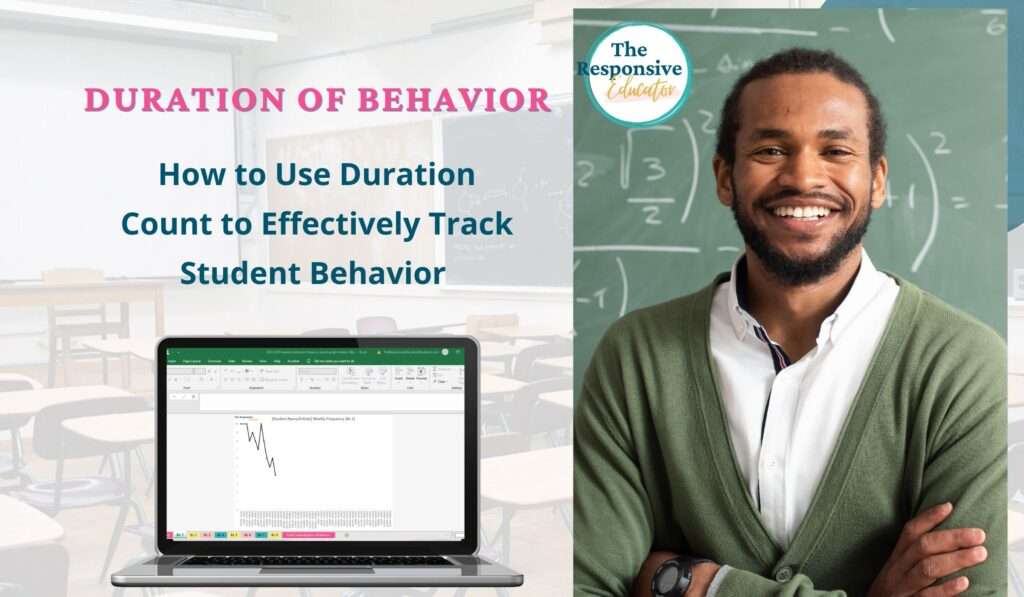
Tracking and measuring student behaviors are essential for providing appropriate interventions and support. One useful method for tracking student behavior is tracking the duration of behavior, which measures the length of time a behavior occurs.
In this article, we will explore when it is best to use duration count, situations where duration may not be the best measurement approach, and examples of behaviors that are not suited to duration count.
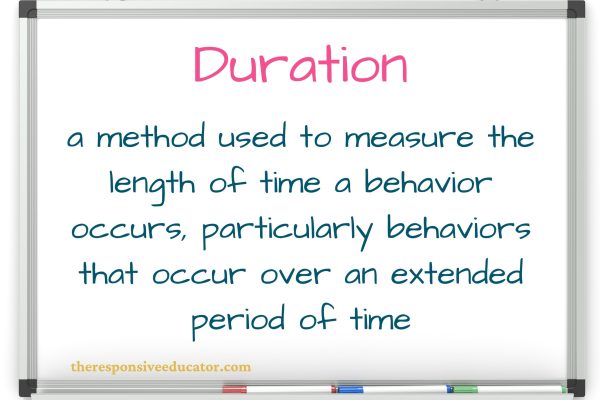
Let me illustrate the significance of tracking behavior duration with a personal experience. I once had the opportunity to work with a student who exhibited physical aggression toward adults on a regular basis and to an extreme extent. It became a challenging situation that often required 2-3 people to be present, blocking his aggression for hours each day. During these episodes, we had to either find a way to remove him from the classroom or evacuate the other students to ensure their safety.
In order to address this issue effectively, we needed to collect data that would demonstrate the significance of the behavior and support our request for additional services. Traditional methods like tracking behavior frequency proved impractical in this case because it was difficult to determine a clear beginning or end to the behaviors, making it challenging to count them accurately.
To overcome this obstacle, we decided to track the duration of the behavior each day. Specifically, we recorded the time spent by one or more adults blocking the physical aggression (such as hitting, kicking, spitting, and throwing objects at us) while not placing any academic demands on him. By consistently collecting this data, we were able to demonstrate that he required at least 1-on-1 adult attention for a minimum of 4 hours per day.
Note: I am an Amazon Affiliate. If you purchase products through the links provided, I will earn a small commission at no extra cost to you, which helps support the blog.
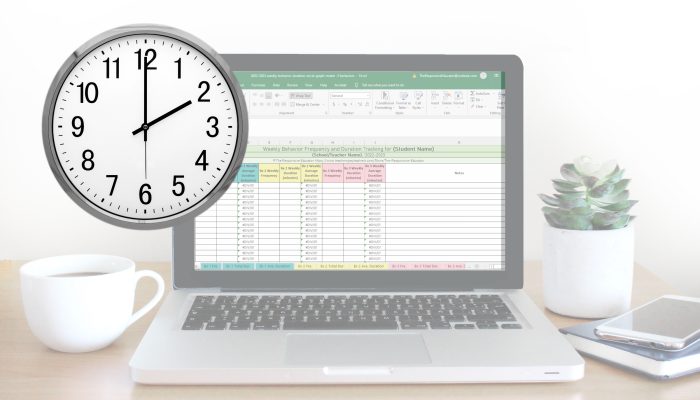
Furthermore, we also counted the total hours required for blocking (4 hours multiplied by the number of adults involved) to provide a comprehensive understanding of the impact of these episodes. This approach not only revealed the length of time the behavior lasted but also provided a measure of the total “man-hours” needed during these episodes.
Tracking the duration of behavior can offer valuable insights when collecting behavioral baseline data, as well as when completing a functional behavior assessment. It can also support the case for additional resources and interventions. Now, let’s delve deeper into situations where duration count is beneficial and explore examples of behaviors that may not be suited for this measurement approach.
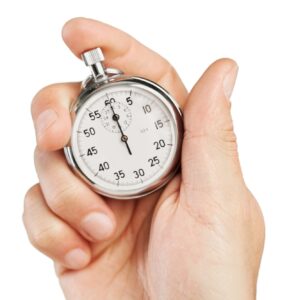
Duration count is a method used in behavioral analysis to measure the length of time a behavior occurs, which is particularly useful when dealing with behaviors that occur over an extended period. It differs from frequency count, which only counts the number of times a behavior occurs. For example, if a child engages in finger tapping, using frequency count would only count the number of times the child tapped their fingers. However, using duration count would also track how long each finger-tapping session lasts.
Measuring the duration of behavior is especially useful when tracking behaviors that occur over a prolonged period or intermittently, such as tantrums. Instead of simply counting how many tantrums a child has, duration count can be used to track the length of each tantrum. By measuring the duration of time a student spends in a tantrum, educators can gain insights into patterns, triggers, and the frequency of the behavior. This information can be used to develop strategies to prevent or mitigate tantrums and promote positive behavior.

In situations where behaviors persist for an extended period, such as seizures or panic attacks, duration count provides a more accurate measurement of the behavior’s intensity and impact compared to a simple frequency count.
Additionally, behaviors that occur unpredictably or vary in duration, such as child outbursts, are more effectively tracked using duration count. By utilizing duration count in these situations, researchers and practitioners can gain a more comprehensive understanding of the behavior and its impact on the individual.
While frequency count is a popular method for tracking student behaviors, there are some behaviors that may occur rapidly and repeatedly, making it difficult to accurately count them using a frequency measure. In these cases, using a duration count can provide a more accurate representation of the frequency and intensity of the behavior. Here are the things to consider when implementing duration count to track student behaviors:
As always, it’s vital to clearly define the behavior you will be tracking to ensure consistency and accuracy in data collection. If you need help operationally defining target behaviors, see this post: How to Use Behavioral Baseline Data to Set Realistic Goals and Measure Success.

Duration is calculated by measuring the length of time a behavior occurs. To calculate the duration of a behavior, start a timer when the behavior begins and stop the timer when the behavior ends. The elapsed time between the start and end of the behavior is the duration.
For example, if a child engages in finger tapping, you would start the timer when the child begins tapping their fingers and stop the timer when they stop tapping. The length of time between the start and stop of the timer is the duration of the finger-tapping behavior.
Decide how long you will be tracking the behavior. Since duration count involves tracking the length of time a behavior occurs, it’s important to choose a time frame that is long enough to capture a representative sample of the behavior, but not so long that it becomes difficult to track consistently.

For example, an educator may want to track the duration of a student’s off-task behavior during a 30-minute class period. If the student was off-task for 15 minutes during that period, the educator would record the duration of the behavior as 15 minutes. It is important to ensure that the data collected is accurate and reliable. One key component of this is to observe the behavior over multiple class periods or days.
Additionally, once an intervention has been put into place, duration data can be useful for tracking progress toward behavior goals over time.
During the observation period, use a stopwatch or timer to record the length of time the behavior occurs. For example, you might use a timer to track how long a student engages in off-task behavior, or how long they remain focused on a task.
To track behavior duration, you can choose from several tools, including a simple and affordable stopwatch or timer, or apps and software designed for behavior tracking. For a traditional stopwatch, this option is a great choice. It’s portable, easy to use inside or outside of the classroom, and is versatile with multiple functions like a clock, alarm, and countdown timer.
Another great choice is something many teachers already have in their classrooms. These simple and colorful timers are easy to use without creating an interruption to your lesson. You can start and stop the timers as your student starts and stops the target behavior, giving you a total at the end of your designated time frame.
If you want a more discrete option, consider this smaller stopwatch that can be worn on one finger. It’s a little more expensive, as it is specifically designed for timing laps and splits in swimming, but it also works great for tracking behavior duration. The compact size and lightweight design make it easy to carry and use discreetly. Wear it on your finger like a ring, freeing up your hands for other tasks in the classroom, or take it on the go for outdoor activities or field trips.
Once you have collected the duration count data, review and analyze it to gain insights into the behavior. Look for patterns and trends in the data that may indicate areas where intervention or support is needed.

To ensure accurate and reliable data collection when using duration count, here are some tips to keep in mind:
By following these steps and tips, teachers can use duration count to gather valuable data on student behaviors, which can be used to make data-driven decisions and support positive outcomes in the classroom.
Duration count is an effective method for tracking and analyzing behaviors that occur over a prolonged period of time or intermittently. For example, out-of-seat behavior, talking out of turn, and tantrums are behaviors that are well-suited to the measurement of the duration of behavior.
Out-of-seat behavior refers to a student leaving their assigned area without permission. To track this behavior effectively, educators can use duration count when the behavior occurs for extended periods of time. By measuring the duration, educators can gain insights into the frequency and duration of the behavior, helping to identify patterns or triggers. This information can then be used to develop interventions that promote positive behavior and minimize disruptions.
Monitor Intervention Effectiveness: Continuously collect duration count data and evaluate the impact of the interventions. Observe if the student’s time spent out of their seat decreases or stabilizes. Adjust the interventions as needed to support positive behavior change.
Talking out of turn, which occurs when a student speaks when they are supposed to be listening or working, can also be effectively tracked using duration count.
Measuring the duration of time a student spends talking out of turn provides insights into the frequency and duration of the behavior. This data can help educators identify patterns, such as higher occurrences during group work or when students feel unheard. Based on this information, targeted interventions can be developed to foster appropriate communication skills and encourage respectful interactions.

Measuring the duration of time a student spends talking out of turn provides insights into the frequency and duration of the behavior. This data can help educators identify patterns, such as higher occurrences during group work or when students feel unheard. Based on this information, targeted interventions can be developed to foster appropriate communication skills and encourage respectful interactions.
Tantrums refer to intense emotional outburst often exhibited by children who are overwhelmed or frustrated. If you have ever asked yourself, “How long does a tantrum last?” measuring the duration of the behavior will be the way to answer that question.
Duration count can be used to track the duration of time a student spends in a tantrum, which can help identify specific triggers or patterns. This information can be used to develop strategies to prevent or mitigate tantrums and promote positive behavior.
Overall, duration count can be a useful tool for educators to gather data and identify patterns in student behavior. By using this information to develop targeted interventions and strategies, you can promote positive behavior change and create a supportive and effective learning environment.

Graphing duration count data in Excel can help identify patterns and trends in the amount of time a behavior occurs, which might not be as apparent when looking at the raw data alone. For example, you might notice that the duration of a certain behavior increases or decreases over time, or that there are certain times of day when the behavior is more or less likely to occur. This information can be invaluable in making data-driven decisions to support students and improve outcomes in the classroom.
When you are tracking behavioral data on a student and something important changes, either at home or at school, entering a line on your graph to delineate where the change took place helps to determine what variables may be having a positive or negative impact on student behavior. Changes could include things like a change in teacher or class, or personal life events such as moving, parents getting divorced, or starting/stopping medication.
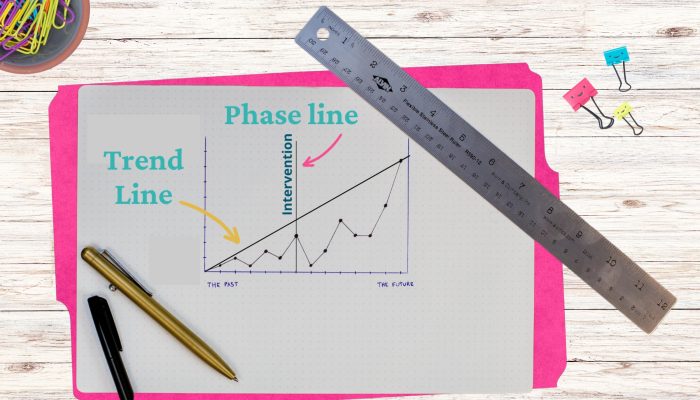
A trendline shows whether the data is trending upward or downward (in other words, is a behavior increasing or decreasing.
To include a trendline on your graph, click on the graph. Then click on the + that will appear in the upper right-hand side of the graph and click the box for trendline.
While duration count is a useful tool for measuring certain types of behaviors, it may not be the best approach for every behavior. Some behaviors that are not well-suited for duration count include hand raising, asking for help, and aggression.
Hand raising and asking for help are behaviors that typically occur in discrete events rather than over a prolonged period of time. For example, a student may raise their hand for a few seconds to ask a question or request help. Duration count may not be the best measure for these behaviors, as it may not accurately reflect the frequency of the behavior. Frequency count or other measures such as the percentage of opportunities may be more appropriate.

Aggression, such as hitting, kicking, or biting, can occur rapidly and may not lend itself well to measurement using duration count. It is important to note that in the case of physical aggression towards others, immediate intervention is crucial for ensuring the safety of everyone involved, rather than allowing the behavior to continue solely for the purpose of collecting duration data. Therefore, duration count may not be the most suitable measurement for isolated incidents of aggression that occur sporadically throughout the day or week.

Furthermore, when it comes to physical aggression directed toward peers, the primary concern is the safety and well-being of all individuals. In such cases, the priority is on preventing and addressing the aggressive behavior promptly, rather than focusing on obtaining a duration count. Alternative measurement approaches, such as frequency count or other relevant measures, may be more appropriate for accurately capturing and addressing aggressive behaviors.
It is crucial to emphasize that when dealing with aggression, the immediate safety of everyone involved takes precedence over data collection. Educators and behavior specialists should prioritize implementing proactive strategies, providing appropriate interventions, and ensuring the well-being of students and staff in order to create a safe and supportive learning environment.
If you would like an overview of the most common types of behavior data collection used in schools, take a look at my FREE resource, Data Collection for Behavior.
Duration count is a valuable tool for measuring and analyzing behaviors that occur over a prolonged period of time or intermittently. By accurately tracking the duration of behaviors such as out-of-seat behavior, talking out of turn, and tantrums, educators can gain valuable insights into behavior patterns and develop targeted interventions and supports to promote positive behavior change.
However, it’s important to note that duration count may not be the best approach for every behavior. When selecting a measurement method, it’s important to consider the nature of the behavior in question and choose the method that will provide the most comprehensive understanding of the behavior’s frequency, intensity, and impact on the individual and their environment.
Are you looking for an easy way to track student behavior duration and monitor progress on student behaviors that seem to take up so much time each day? Look no further than Duration ABA – the ultimate hassle-free solution for educators who want to accurately measure and graph how long a student’s behavior lasts.
With Duration ABA, you can quickly and easily enter behavior duration data and generate customizable graphs that help you identify patterns and trends. Say goodbye to the time-consuming task of creating Excel graphs and hello to a product that simplifies behavior data collection and progress monitoring.
This product is incredibly easy to use and comes with detailed instructions to help you get started. Plus, it’s fully customizable to fit your specific needs. With Duration ABA, you can focus on what really matters – your students’ progress and success.
Don’t waste any more time creating tedious Excel graphs. Try Duration ABA today and experience the difference it can make in your behavior data collection and progress monitoring. Click here to find it now!